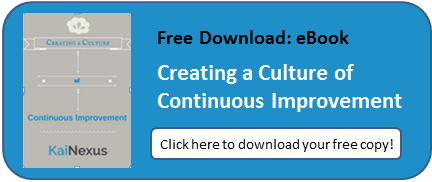 If you suggest to a group of business leaders that companies should always be working to improve, the response you will get is likely, “Duh.” It’s not really a subject of much debate.
If you suggest to a group of business leaders that companies should always be working to improve, the response you will get is likely, “Duh.” It’s not really a subject of much debate.
However, if you dig deeper and inquire about the specific business practices designed and deployed to support continuous improvement, many are at a loss. Some assume that improvement simply occurs naturally without specific effort and others are unsure about what steps to take. We are fortunate to have had the opportunity to speak with many leaders about the subject and have compiled some of the best practices for continuous improvement that they have shared.
Start at the Top - And the Bottom
In order for an organization to gain the benefits of continuous improvement over the long run, every employee must adopt a mindset that seeks out opportunities for positive change. Executive leadership is necessary to reinforce and model the approach, as well as to clear barriers and supply essential resources. However, continuous improvement can’t be something that occurs behind board room doors. Employees who are on the ground, executing and seeing the results of business processes are best positioned to recognize opportunities for improvement and implement them. The most successful companies see continuous improvement as an all-in way of life.
The most successful companies see continuous improvement as an all-in way of life.
Define Standard Work
Before you can improve something, you have to know exactly what it is. If “Process A” is preformed differently depending on who is doing it, it is very difficult to identify what should be improved and almost impossible to measure the impact of the improvement. The act of simply defining the current best practice for a given process or activity is often highly educational and useful on its own. It is a necessary prerequisite for any improvement model. As Masaaki Imai wrote, "Without standards, there can be no Kaizen."
Control the Process of Change
Once organizations free themselves of the, “If it ain’t broke, don’t fix it,” mindset and embrace the fact that all processes can be improved and improvement is necessary to remain competitive, there can be a rush to change for the sake of change. We’ve seen this lead to chaos and confusion. This is why it is a good idea to apply a process for change. The Plan, Do, Study, Adjust (PSDA) model has proven to be a useful way to implement gradual changes in a systematic way that will get meaningful results.
Capture Tribal Knowledge
One common practice in companies that are successful at continuous improvement is that of documenting the results and impact of change, as well as the process used to achieve it. When every step of the improvement process, from the initial identification of an opportunity for improvement, through the vetting of the idea and the execution, is captured and made available for others to review, the speed of improvement accelerates. One idea can build on recent, successful improvements can be spread to different processes in different parts of the organization.
Recognize and Reward Engagement
Employees get a sense of what management values, not by what is said, but by what is done. Recognizing and rewarding employees who are engaged in improvement is a vital responsibility of leaders who want improvement to thrive. When improvement initiatives are first introduced, it is not uncommon for employees to fear that their suggestions will be seen as complaints that are not really welcomed by management. Expressing gratitude when team members participate in positive change helps alleviate this concern and clears the way for increased employee involvement.
Of course, every organization approaches continuous improvement in its own way. Some deploy specific business methodologies, like Lean and Six Sigma, while others take a more simple approach. Regardless of the path you choose, these best practices can form the foundation of your improvement efforts.



Add a Comment